Jen Black's Blog, page 101
February 5, 2013
Richard and the Silver Boar
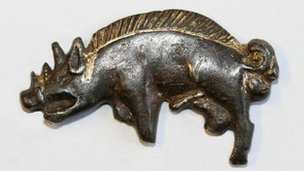 Like every other history buff the world over, I watched the Channel 4 programme on Richard last night. While I was fascinated, I was also irritated by the chopping and changing deemed necessary by the programme makers! Just as we got to some interesting bit, then the story would revert back to how Phillipa felt as she stood over the R painted on the tarmac of the car-park, or the frizzy haired presenter would warble on about what he thought, or Laurence Olivier's dreadful performance as the king would declaim a few choice words from the Shakespeare play. Which reminds me - no one ever explained the significance of the R on the tarmac. Who put it there, and why? (Reading newspaper reports today, I gather it meant Reserved space and had nothing to do with the fact that Richard was buried beneath it.)
Like every other history buff the world over, I watched the Channel 4 programme on Richard last night. While I was fascinated, I was also irritated by the chopping and changing deemed necessary by the programme makers! Just as we got to some interesting bit, then the story would revert back to how Phillipa felt as she stood over the R painted on the tarmac of the car-park, or the frizzy haired presenter would warble on about what he thought, or Laurence Olivier's dreadful performance as the king would declaim a few choice words from the Shakespeare play. Which reminds me - no one ever explained the significance of the R on the tarmac. Who put it there, and why? (Reading newspaper reports today, I gather it meant Reserved space and had nothing to do with the fact that Richard was buried beneath it.) I wanted more detail on the bones and what they told us, so I'll have to wait for the scholarly write up. What about his diet? Did they investigate his teeth so they could us where he passed his childhood, why were so many of his teeth missing; were they lost in the burial, knocked out at the point of death, or generally lost sometime in life? One sentence said he had an upper class diet with plenty of fish and meat. There must be more than that to come.
I wanted more detail on the bones and what they told us, so I'll have to wait for the scholarly write up. What about his diet? Did they investigate his teeth so they could us where he passed his childhood, why were so many of his teeth missing; were they lost in the burial, knocked out at the point of death, or generally lost sometime in life? One sentence said he had an upper class diet with plenty of fish and meat. There must be more than that to come.Facial reconstructions have been done before, by the same Dundee University team, and I have held the sneaking thought that they all looked rather alike. I think what I see as a likeness is given by the plastic used in the method of creating the facsimile head. This one was passably close to the portraits of Richard, which was pleasing, and made him look very young, even for thirty-two. This is a link here to the Richard III Society for anyone who wants more background, or to try and understand the reason for all the fuss. I'll be popping back myself, as well as waiting for the scholarly reports. It will be interesting to see if any other university undertakes comparitive tests, and if their conclusions agree with those of Leicester. And I do wish they'd decide to bury him at York Minster; after all, he was the Lord of the North and lived a good part of his life in Yorkshire.
Published on February 05, 2013 11:44
February 4, 2013
It is Richard III
 The Leicester press conference has just confirmed that the bones sought and found in the car park are indeed those of Richard III. There is a Channel 4 programme tonight about the search and the results, and it will be interesting to see what kind of reach it has in viewing figures.
The Leicester press conference has just confirmed that the bones sought and found in the car park are indeed those of Richard III. There is a Channel 4 programme tonight about the search and the results, and it will be interesting to see what kind of reach it has in viewing figures. There are a lot of excited history buffs commenting on Twitter, but all at once 120 new Tweets arrived, most of which were people attempting to be funny and wanting to know if Richard would have a valid car parking ticket since he's been parked there for 526 years. I suppose it's mildly funny the first time, but the 119th comment is a bit of a drag.
However, I think it would be wonderful if instead of burying Richard in Leicester, they took his remains to York and buried him in the minster. York was always his city and the good people of York had the guts to write of their feelings for him once Henry was proclaimed king. "to the great heaviness of this city...."
I wonder if there will be a spate of books about Richard now he's in the news, so to speak? Richard's ghost seeks vengeance - I can see it now. Somebody is bound to write of his quest to hunt down Henry Tudor...maybe even get to grips with the current monarch. I expect he'd be shocked to see that it is a female. Just wouldn't fit with his mind set.
PS If they decide to make a film of Richard's life, I can see Richard Armitage as Richard III
Published on February 04, 2013 03:16
February 1, 2013
Fiction Failures
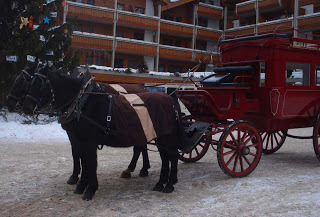 While I was in Zermatt I did a lot of reading - Kate Morton's Forgotten Garden, to be precise, and enjoyed it until I got to the very end and couldn't believe in the reason the child was alone on the ship. I don't want to say more of the storyline, but those of you who have read it may agree with me. That mystery had been a thread throughout the whole book, and I wanted so very badly to know why it had happened. I'm afraid the weak raison d'etre cast the entire story into doubt.
While I was in Zermatt I did a lot of reading - Kate Morton's Forgotten Garden, to be precise, and enjoyed it until I got to the very end and couldn't believe in the reason the child was alone on the ship. I don't want to say more of the storyline, but those of you who have read it may agree with me. That mystery had been a thread throughout the whole book, and I wanted so very badly to know why it had happened. I'm afraid the weak raison d'etre cast the entire story into doubt. Then I read Goddard's Set in Stone. Again, a wonderfully atmospheric story about a house that twists people's minds, but then in the last few pages - a railway ticket in the post and I couldn't understand it's significance. I obviously ought to have understood - but I didn't.
It is things like these that make me so very wary in own writing. Is the basic plot both strong and believable? Am I expressing character in the way I should? Is everything in my head clear on the page? Will readers close the book and toss it aside, saying Rubbish! because they couldn't figure out what was happening?
So now I've begun Trollope's The Other Family, and noticed something that has been annoying me for ages. It's the increasing frequency of sentences like this: "it was perfectly possible to hand-wash most stuff, not take it to the dry-cleaner's." I would rather the sentence read 'dry-cleaner.' Why add the apostrophe, which indicates the writer means the dry-cleaner's shop, if said writer cannot be bother to add the word itself?
I hope it is not the modern trend to write novels in the same sloppy, slangy way we speak. One of the things I love about reading is discovering the astonishing beauty of clear prose and I would hate to lose that for the sake of being trendy.
Zermatt - some hotels pick up guests from the Bahnhof (station) in carriages that look like the Wells Fargo stage in cowboy films. The thunder of hooves and rolling wheels as they trot down the snowy streets is exciting to watch, and then the whiff of horse as they go by - wonderful!
Published on February 01, 2013 02:17
January 30, 2013
Looks can be deceiving
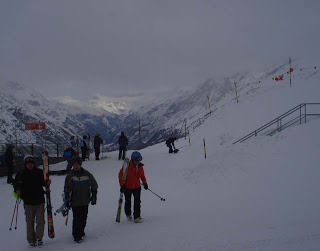 Mountains can look unappealing in poor weather, when the sky and the snow merge into one strangely blank expanse of grey.
Mountains can look unappealing in poor weather, when the sky and the snow merge into one strangely blank expanse of grey. Visibility was poor on our first day. We took our skiis on the train and ventured up to Rotenboden (unforgettably dubbed Rottenbottom by a couple of seven-year-old English children on a previous holiday), thinking that our "favourite" run would be easy enough.
The run descends to Riffelberg and is a swooping rollercoaster of a run that leads directly to the sun terrace of the Riffelberg hotel where hot chocolate awaits. The problems began right away - my skiis would not slide. Very odd. I stood on a slope, pointing down the fall line, and did not move. Dh finally admitted he'd coated the skiis with WD40 when he stowed them in the garage after our last trip.
So, there followed much swishing of skiis back and forth in the snow until the wretched WD40 was polished off. We earned strange looks from other skiers, I can tell you. Then we could ski. We set off and soon found we'd descended into mist, cloud, call it what you will. Skiing palls for me when I cannot see more than ten feet ahead of me, when the snow suddenly disappears under your skiis and you land with a thump somewhere down the hill you couldn't see.
We got down, had a hot chocolate and waited to see if the weather would clear, but if anything it got worse. In perfect agreement, we got the train down to Zermatt and headed for the leisure pool and two jacuzzis at the hotel. Call it cowardice if you like. We prefer to say there's always tomorrow.
Published on January 30, 2013 01:34
January 27, 2013
Winter Holidays
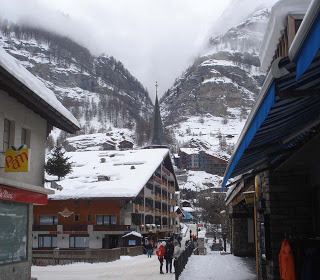 I've just had a week's holiday without a computer and you know what that means - no blogging, no working on the story, no dipping into Facebook or Twitter and guess what - did I miss it? Not at all!
I've just had a week's holiday without a computer and you know what that means - no blogging, no working on the story, no dipping into Facebook or Twitter and guess what - did I miss it? Not at all!It may have had something to do with the holiday being an active one. We went skiing in Zermatt and given my current levels of fitness, plus the fact that for the ten days before we flew I'd had the most abysmal bug which kept me in bed for almost a week, seven days skiing took every ounce of energy I had. I am not as fit as I used to be, that's for sure!
We took off on the 19th with doubt in our minds. Would Geneva be snowbound or not? We landed safely and were then presented with a trek to the Inghams coach. The walk was long enough not to be recommended even when unencumbered, but with suitcases, ski boots and skis to manage, definitely a no-no situation. The coach, which was supermodern and only a third full, no doubt a reflection on the current financial climate, took us to Tasch, from which point no automobiles are allowed further up the valley to Zermatt. Trouble was, our train tickets were with the Inghams rep, who was not there to meet us! He arrived half an hour later, full of apologies, blaming miscommunication between reps. We were not impressed. When we arrived in Zermatt we had another ten minute wait for the hotel taxi, and standing around at night in sub-zero temperatures is no joke. Picture us even less pleased than before.
It was only when we got to the Park Hotel Beau-Site in Zermatt and walked into the warmth and light that we felt we could relax. We thawed out and went down to dinner. The food is always terrific there, and the Swiss wines are astonishingly good. It's only a pity they never make it out of Switzerland. They do so that the Swiss are the heaviest wine drinkers in Europe, but I don't know if that is true. Their diet is heavy in cheese and fat in all forms, but strangely, they also hold the record for the healthiest nation in Europe. Must have something to do with the altitude, and maybe the cold.
Next year, we shall book with the hotel and make out own travel arrangements.
Published on January 27, 2013 17:30
January 26, 2013
Holiday over
You may have noticed I've been rather quiet this week and that's because I've been on holiday. I set up Blogger to show Anita's new book, and also to show my review of the title. Well, now I'm home I see that Blogger failed to publish the post I scheduled for midweek. Not only is Blogger acting up over producing photographs, but now it's getting picky over what it will and won't schedule. Let's hope it sorts itself out soon, otherwise, Other Measures will have to be considered.
We've been skiing in Zermatt, and I have lots of new pics to show. There is rather more snow in Zermatt than here, but it was quite a surprise to fly over the south coast of England and see snow all the way up to Newcastle and beyond. Not often that happens! So tomorrow I'll sort myself out after a good night's sleep and resume business as usual. Except that I'll have a spate of cooking to do, because there has been a power cut while we've been away, and some of the freezer contents are now somewhat less than frozen. Rather than refreeze or throw them out, I'll cook them first thing. Also, we must discover who has cleared our drive of snow while we've been away.
We've been skiing in Zermatt, and I have lots of new pics to show. There is rather more snow in Zermatt than here, but it was quite a surprise to fly over the south coast of England and see snow all the way up to Newcastle and beyond. Not often that happens! So tomorrow I'll sort myself out after a good night's sleep and resume business as usual. Except that I'll have a spate of cooking to do, because there has been a power cut while we've been away, and some of the freezer contents are now somewhat less than frozen. Rather than refreeze or throw them out, I'll cook them first thing. Also, we must discover who has cleared our drive of snow while we've been away.
Published on January 26, 2013 11:24
January 18, 2013
Anita's Book - Royalist Rebel

Today I am hosting Anita Seymour's introduction to her new book: Royalist Rebel . Here's what she has to say about it:
Intelligent, witty and beautiful, Elizabeth Murray wasn’t born noble; her family’s fortunes came from her Scottish father’s boyhood friendship with King Charles. As the heir to Ham House, their mansion on the Thames near Richmond, Elizabeth was always destined for greater things.
Royalist Rebel is the story of Elizabeth’s youth during the English Civil War, of a determined and passionate young woman dedicated to Ham House, the Royalist cause and the three men in her life; her father William Murray, son of a minister who rose to become King Charles’ friend and confidant, the rich baronet Lionel Tollemache, her husband of twenty years who adored her and John Maitland, Duke of Lauderdale, Charles II’s favourite.
With William Murray at King Charles’ exiled court in Oxford, the five Murray women have to cope alone. Crippled by fines for their Royalist sympathies, and besieged by the Surrey Sequestration Committee, Elizabeth must find a wealthy, non-political husband to save herself, her sisters, and their inheritance.
Royalist Rebel by Claymore Books, an imprint of Pen and Sword, is released on 17th January 2013http://www.pen-and-sword.co.uk/Historical-Fiction/c/146/
For a little background on the novel, see Anita’s Book Bloghttp://royalistrebel.blogspot.co.uk/
The National Trust Website of Elizabeth Murray’s former home, Ham House, at Petersham near Richmond, Surreyhttp://www.nationaltrust.org.uk/ham-house/
Anita’s Bloghttp://thedisorganisedauthor.blogspot.co.uk/
Published on January 18, 2013 02:14
January 16, 2013
A Blue Day
 The day is miserable. Misty and with snow on the ground and a weak sun trying to push through and so far, failing. My cold is hanging on, won't go away. Now, to add insult to injury, Blogger have changed the way we have to upload photos. Since I don't have pictures on my phone, I don't have a webcam, don't use Picasa web albums, etc etc, it seems I can't upload pics any more. Surely the simplest way for most people was to upload from their computer? Have Blogger forgotten this?
The day is miserable. Misty and with snow on the ground and a weak sun trying to push through and so far, failing. My cold is hanging on, won't go away. Now, to add insult to injury, Blogger have changed the way we have to upload photos. Since I don't have pictures on my phone, I don't have a webcam, don't use Picasa web albums, etc etc, it seems I can't upload pics any more. Surely the simplest way for most people was to upload from their computer? Have Blogger forgotten this?So the only pic I can get up here today is an old one. (I've sent feedback. Let's see if they respond.
Since nothing I do today is turning out well, it is perhaps a good thing I'm due in town for a hair cut. We've promised ourselves lunch as well. It will do us good to be out among people again, since we've been isolated for the past ten days or so, brewing our germs and bugs among ourselves instead of going out and spreading them among the unsuspecting populace. Noble, don't you think?
Usually I don't have many outside appointments to keep, but now that snow is here and heavy snow is forecast for tomorrow, wouldn't you know it - I have a date to keep on Thursday and another on Friday, both of which involve me in driving a 50 mile round trip over hilly country. It would be easy if only I were involved, but both days other people are involved, so it is not an easy decision about going or not going.
Published on January 16, 2013 02:55
January 14, 2013
Let's have a Coffee
 Coffea arabica is indigenous to Ethiopia and Sudan. People took the beans on long journeys and chewed them for both nourishment and stimulation. There may have been a fermented drink, called kahweh, which is a word Moslems use for wine but it was viewed with disfavour.
Coffea arabica is indigenous to Ethiopia and Sudan. People took the beans on long journeys and chewed them for both nourishment and stimulation. There may have been a fermented drink, called kahweh, which is a word Moslems use for wine but it was viewed with disfavour.By the fifteenth century a drink made from coffee beans and an infusion of water had became known in Arabia and it spread through the Middle East and reached Turkey by 1530.
Travellers brought the drink to England. The earliest coffee-house was set up in Oxford, at the Angel Inn, in 1650, though individuals had been seen drinking coffee there as early as 1637. Two years later, London had its first coffee-house in St Michael's Alley, Cornhill, and others swiftly followed. They catered to an all-male clientele.
Coffee was expensive,and soon became liable to excise duty, which added tot he cost. A dish of coffee sold for 1d (one penny) and in 1685 powdered beans sold for 3/- per pound. (Three shillings). By 1693, the price had doubled. The coffee houses did not raise the prices, but simply watered the coffee.
The Dutch took the bean to their East Indian colonies at the end of the seventeenth century, and later it was introduced into the West Indies, some Central American states and parts of South America. The Bedford family at Woburn Abbey first started drinking coffee in the late 1670s and they were typical of other families in that their consumption gradually rose until coffee succeeded ale and beer as the breakfast drink of choice. Chocolate, of course, was also taken at breakfast at this time.
Competition arose in the Georgian era, when tea arrived on the scene, and soon became a favourite with the labouring classes. Coffee remained the favoured drink of the gentry. British colonists took coffee with them to Virginia, where it gained popularity after a tax was imposed on tea. Continuing immigrants from Europe kept reinforcing the coffee habit until it became the preferred drink of the country.
Published on January 14, 2013 08:49
January 11, 2013
Orange, anyone?
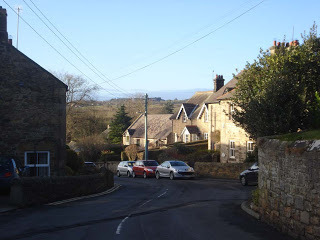 Someone recommended a book called Medieval Underpants as required reading for all historical fiction authors, so I duly got hold of a copy and read it on my Kindle. Basically it is an American author advising American authors that if they wish to write about European History, they must do the research, otherwise they have UK readers in hysterics. I'm not saying she doesn't address English writers as well, but the slant of the book is more geared to Americans. There's lots of good things to learn if you are beginning in the field, but after ten years, probably more than ten now, if I stop to think about it, learning the hard way...the only thing that had me worried was oranges.
Someone recommended a book called Medieval Underpants as required reading for all historical fiction authors, so I duly got hold of a copy and read it on my Kindle. Basically it is an American author advising American authors that if they wish to write about European History, they must do the research, otherwise they have UK readers in hysterics. I'm not saying she doesn't address English writers as well, but the slant of the book is more geared to Americans. There's lots of good things to learn if you are beginning in the field, but after ten years, probably more than ten now, if I stop to think about it, learning the hard way...the only thing that had me worried was oranges.Yes, oranges. I have a character pick one out of a bowl of pears in October in 1543. A dreadful nagging doubt seized me. I was happy enough about the pears - but decided to look up oranges in my book Food and Drink in Britain by C. Anne Wilson written about 1973.
She was most reassuring. Essentially what she says is: Strange and exotic fruits began to arrive in Britian through trade with southern Europe - oranges, lemons and pomegranates. The original home of citrus fruits was India but they travelled east through Persia. Arabs brought them to Spain. Crusaders tried them around Jaffa in 1191. The fruits began to arrive in Britain about a hundred years later. Fifteen lemons and seven oranges plus 230 pomegranates arrived on a Spanish ship to Portsmouth in 1289 for Queen Eleanor, formerly a princess of Castile.
Those oranges were the Seville orange, the bitter type that makes marmalade. An Italian vessel brought a large consignment to the Port of London in 1420. Housewives learned to use them in cooking along with currants, prunes, figs and dates. Pine nuts, and walnuts arrived. Almonds were consumed by the royal household - 28,500 pounds of them in 1286. Poor folk ate them in pottages over the days of Christmas, but wealthy household ate them at other times. Apples and pears taken at the end of a meal were usually roasted and eaten with sugar, comfits, fennel seed or aniseed.
By the sixteenth century oranges were coming into the country regularly, both the bitter and sweet variety. Sir Francis Carew began growing them, certainly before 1562,
in Croydon. So I think I can relax and leave my single orange where it is. And then of course there's Nell Gwynne and her oranges int he next century....
Published on January 11, 2013 05:52
Jen Black's Blog
- Jen Black's profile
- 6 followers
Jen Black isn't a Goodreads Author
(yet),
but they
do have a blog,
so here are some recent posts imported from
their feed.



